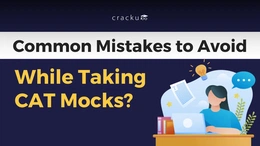Now that the season for upcoming MBA entrance exams has started. Preparing for the CAT exam requires multiple stages of practice and resources. One such resource is Mock. As the CAT exam date gets closer, mock exams become incredibly important. It helps you check how much prepared you are and also improve your strategies. You can check Cracku's CAT Mock. However, just taking mock exams isn't enough; you must also analyse them well. In this article, we'll look at how to analyze CAT Mock with important steps and methods for analyzing CAT mock exams thoroughly. Analyzing a mock test has one main goal: figuring out what you're good at and what you need to work on. Having a proper way of analyzing mock tests is crucial.
How To Analyze Question wise CAT Mocks?
Unattempted Questions
You need to see each unattempted question and evaluate why were you unable to solve those particular questions. You can evaluate by asking the following questions:
- Was the question from your weak areas?
- Was it tough?
- Did you find the questions confusing or lengthy?
- Is it because of close options?Answering these questions can give you clarity and you can better evaluate your mock.
Wrong Questions
Here you need to see why the question went wrong. For VARC, what was the reasoning mismatch? You need to see where was the gap between the author's reasoning and your reasoning behind the answer. You also need to see whether it was a silly mistake or a genuine mistake. For DILR, see if you were able to solve the set. For QA, check if the mistake is about calculations or lack of concept knowledge. Based on these questions, you can better evaluate.
Right Questions
For the questions which were correct, the only thing you need to see is whether there could be any easy solution or alternative solution available by the solutions provider. If there is, you can also learn that solution in order to have a better understanding and solve the question in the minimum time possible.
Guess Questions
There are many questions where the aspirants try to make some guesses. You need to work on it. It's okay if you make a guess but try to make a calculative guess and don't make it in the beginning. Guess can work when you have already reached the threshold of solving and want to go further. Try to narrow down the approaches and reach at least the last 2 solutions.
How To Analyze Section wise CAT Mocks?
Verbal Ability and Reading Comprehension (VARC)
Analyzing the VARC section is more about evaluating whether the reasoning of the author matches your reasoning. If it doesn't, how much variation is there? It's all about catching up to the author's level. Evaluate whether you were able to understand the paragraph and the message the author was trying to convey.
Also, look if you were able to solve the expected questions in the stipulated time. Check what are the areas where there is a mismatch of understanding. Check if there are particular analytical reasoning questions where you are making the mistake.
Also, review all questions regardless of whether you answered them correctly or not, and go through all the questions again. This helps rethink your understanding of the passages and concepts. For verbal ability questions like Para jumbles (PJs), odd sentences, and paragraph summary (PS), spend time understanding the underlying logic. Try to understand the logical sequence or relationship before checking the answers or explanations.
Data Interpretation Logical Reasoning (DILR)
DILR is all about whether you were able to crack the set or not. It's all about understanding the set, the right approach you have to choose and following the clues. Check if you followed the right approach or not, and check if you followed the clues or not.
Many times people misunderstand the clues and that leads them to misinterpretations. You need to stick to the information given in the sets.
It is important to allocate sufficient time to properly read and analyze sets where you answered incorrectly or couldn't solve. Attempt these questions again using your own reasoning before checking the solutions. This process builds independent thinking and enhances problem-solving skills. Resist the temptation to immediately look at solutions when you are unable to solve the set even after taking enough time. Instead, commit to solving them on your own first. Set a timer of about 10-15 minutes and try to solve the LRDI set that you left in the mock. This way help you to make and improvise your strategy.
Quantitative Aptitude (QA)
For QA, it is advisable to analyze the mock test based on the questions-wise strategy mentioned above. You have to evaluate each question. Make sure to not discriminate between the correct and incorrect questions and give both of them enough time for evaluation. Also, see how much time you took to solve the question and how much time the other people took. You can compare the average time taken. In this section, take care of your attempt rate. Though your attempt rates depend on the level of difficulty of the exam, you might not be attempting a sufficient number of questions to achieve your desired sectional percentile. By keeping a tertiary focus on these numbers, you'll be gradually able to push your overall attempts. In this section make a separate notebook in which you are writing your mistakes and important formulae or question that you might feel is important and go through this notebook before taking another mock.
Note down all the mistakes you found from each section and commit to reading them before appearing for any Mock Test and remember to not repeat them again.













![Top CAT Quant Progressions & Series Questions [Download PDF] Top CAT Quant Progressions & Series Questions [Download PDF]](/media/cache/1e/18/1e1804f8e048fddfc82227c7d80319eb.webp)







![Top CAT Quant Quadratic Equations Questions [Download PDF] Top CAT Quant Quadratic Equations Questions [Download PDF]](/media/cache/c2/05/c205c0abdf778ffd7663c253d9b95a8a.webp)

![Most Important CAT Averages Questions [PDF] Most Important CAT Averages Questions [PDF]](/media/cache/54/e8/54e80dac6301b8d404ec410ed272b262.webp)
![Top CAT Geometry Miscellaneous Questions [PDF] Top CAT Geometry Miscellaneous Questions [PDF]](/media/cache/8e/37/8e3760242131aca7d1c068e3459d64a9.webp)


![Top CAT Geometry Triangles Questions [PDF] Top CAT Geometry Triangles Questions [PDF]](/media/cache/2d/40/2d40909ccde09df6707398e3678e445f.webp)




![Top Important CAT Number System Questions [Download PDF] Top Important CAT Number System Questions [Download PDF]](/media/cache/0b/2e/0b2e5f8e097aff36ce62f1f10f334480.webp)
![Top CAT Quant Linear Equations Questions [Download PDF] Top CAT Quant Linear Equations Questions [Download PDF]](/media/cache/cb/00/cb00fafca1806baf52b208410d968299.webp)












